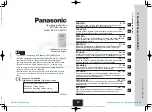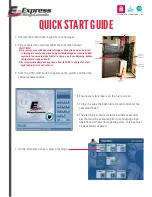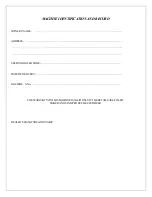
11
SawStop
®
Professional Cabinet Saw Mobile Base
Installing Your Mobile Base - Method 2
3.
Loosen the M8 x 65 countersunk socket head bolt
that mounts the front leg to the front rail, but do not
remove the bolt or nut. Use the 5 mm short-arm
hex key supplied with the mobile base to keep the
bolt from turning while you loosen the nut with a 13
mm wrench (see Fig.
21)
. The 5 mm short-arm hex
key is sized so that it can engage the head of the
bolt without having to remove the front rail tube.
Repeat the procedure to loosen the M8 hex nut on
the back of the M8 x 65 countersunk socket head
bolt that mounts the rear leg to the rear rail. Rotate
the end of each support leg toward the saw so that
both support legs are out of the way and the saw
can be tipped onto its side.
Fig. 23
5. Locate all of the mobile base components shown on page 1. All of the hardware needed to install the mobile
base is located on the hardware pack (see Fig.
23)
. In order to easily identify the hardware used in each of
the following steps, the different pieces of hardware are numbered on the hardware pack and in the figures.
If you are missing the hardware pack or any of the other mobile base components, call the SawStop Service
Department at 503-582-9934 for replacements.
You will need the following tools to complete the
mobile base installation
:
• 5 mm hex key
• 6 mm hex key
• 10 mm socket
• 10 mm wrench
• 14 mm wrench
• 17 mm wrench
Professional Cabinet Saw Mobile Base Hardware Pack
Extension Spring, (1)
8
Lock Washers,
M8 x 13.6 (4)
2
Washers,
M8 x 18 (2)
4
Washers,
M6 x 16 (2)
14
Flange Lock
Nuts, M6 (2)
15
Hex Bolts,
M6 x 40 (2)
13
Lock Washers,
M10.5 x 17 (4)
11
Caster Nuts,
3/8” thread (2)
16
Button Head Socket
Bolts, M8 x 35 (2)
1
Lock Nuts,
M6 (2)
7
Shoulder Socket
Screw, M8 x 17.7 (1)
9
Button Head Socket
Bolts, M10 x 40 (2)
10
Washers,
M10.5 x 20 (4)
12
Button Head Socket
Bolts, M8 x 20 (2)
3
Button Head Shoulder
Socket Bolts, M8 x 20 (2)
5
Fixed Wheel Axles
6
Fig. 21
loosen the M8
hex nut enough
so that the sup
-
port leg can rotate
use the 5 mm short-arm
hex key to keep the bolt
head from rotating
4.
With the front and rear rails are securley mounted, any out-feed table removed, and the extension table legs
removed or rotated out of the way, the saw can be tipped to the side. To make the saw easier to tip, adjust the
tilt handwheel until the blade is set at 45
°
to the table. Make sure the saw is on a level surface and then, with
the help of an assistant, grip the sides of the rails near the ends and push down to gently lower the rails to
the ground (see Fig.
22)
. Do not grip an extension table or the end of the rails to lower the saw to the tipped
position because you might pinch your fingers between the extension table or rails and the ground. The rear
rail is shorter than the front rail and typically will not touch the ground. To prevent scratching the rails, you can
set the edge of the front rail on a piece of cardboard or cloth.
Fig. 22
push down on the rails and gently
lower the saw to the tipped position










































